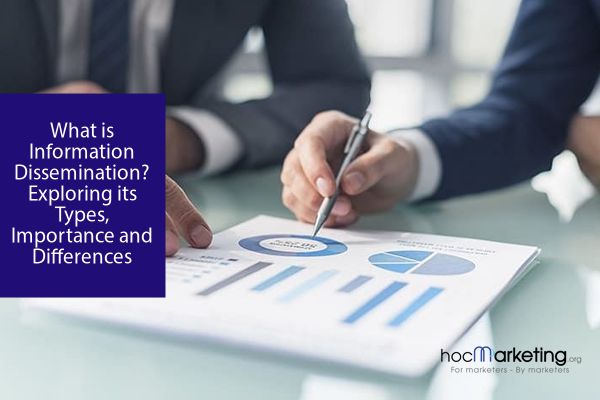
What is Information Dissemination? Exploring its Types, Importance and Differences

Information dissemination is the process of sharing scientific and technological information to those who need it It is important due to the problem-centered nature of adult learning, solving information overload, and resolving inaccurate information issues Customizing the medium, message, method, time, location, media, and language of dissemination is crucial Approaches include information sessions, workshops, seminars, webinars, and traditional media outlets
What is Information Dissemination?
The effective distribution of scientific and technological information to the intended audience is known as information dissemination. In order to maximize the impact of research, it is crucial to make the findings easily accessible and comprehensible to a wider audience.
The act of sharing information with others, whether it be new or pre-existing, can be achieved through various means such as verbal communication, writing, or technology. This process, known as information dissemination, is vital in ensuring that the intended audience receives the information effectively. While commonly associated with news media, dissemination can also be utilized in other forms of communication like marketing or advertising. In recent years, advancements in technology have significantly impacted the way individuals and organizations communicate information to the general public, expanding beyond traditional face-to-face conversations and written correspondences.
To effectively educate and inform specific groups about issues, possibilities, and problems of their interest, a proactive information service must implement a systematic approach to planning, gathering, organizing, and storing information. Given the constantly changing and evolving resources and information surrounding the coronavirus, it is crucial to prioritize information dissemination to ensure individuals have access to the most current and accurate information, enabling them to protect themselves and their loved ones.
Why Disseminate Information?
In today's digital age, information can be disseminated in various ways, from traditional media such as television, radio, and print, to newer forms such as social media and the internet. However, each source may have its biases or limitations, which is why it's essential to cross-check information from multiple sources to obtain a more comprehensive and accurate understanding.
Sharing knowledge is the primary reason behind disseminating information. In the context of business, companies often disseminate new information about their products or services to customers and prospects through marketing campaigns and other forms of advertising.
The news media plays a crucial role in sharing current events with the public. Through various platforms such as newspapers, television news programs, and radio broadcasts, information is disseminated to a wide audience. However, information sharing is not limited to these formal channels. On a more personal level, friends may share information about new experiences, like trying out a new restaurant, with the intention of simply sharing knowledge rather than promoting anything specific.
Communication is crucial in healthcare research to ensure that studies are effectively conveyed to the public in a comprehensible manner. Effective communication strategies are vital for the proper processing and dissemination of information. The field of healthcare and public health research is currently experiencing a significant amount of interest.
How is Information Disseminated?
Information can be shared in various ways, with verbal and written communication being the most prevalent methods. Verbal communication includes face-to-face conversations, phone calls, and speeches, while written communication can take the form of emails, letters, articles, and books. In today's digital age, technology has also revolutionized the dissemination of information with the widespread use of the internet, social media, and text messaging, making it faster and easier to share information with others.
The ultimate objective of disseminating information is to effectively deliver it to the target audience, regardless of the approach employed. In order to achieve this, it is crucial to select the appropriate communication tactic based on the intended audience and message.
When selecting a communication strategy, it is crucial to take into account the alignment of the message with the interests of the intended audience. A message that resonates with the audience's interests is more likely to be received and absorbed effectively. Equally significant is the type of information being shared, as some information demands distinct communication strategies based on its complexity.
Importance of Information Dissemination
Information dissemination is crucial as it empowers individuals with the necessary knowledge to make informed choices. This is particularly important in situations where decisions can have significant consequences.
1. Problem-centered Nature of Adult Learning:
Information dissemination is crucial for individuals to make informed decisions. Adults, being more independent than children, require a greater amount of information to make decisions.
2. Special Nature of Information Dissemination for Adult Community:
When it comes to sharing information with adults, the approach needs to be different than with children. Adults require specific and accurate details on a topic of interest, making it necessary to customize the information to meet their needs.
3. Solving Information Overload:
With the abundance of information in today's society, it can be challenging for individuals to sift through the noise and locate the specific information they require. This is where information dissemination comes into play, as it serves to facilitate access to necessary information and thus address the issue of information overload.
4. Resolving Inaccurate Information Issues:
In today's digital age, the abundance of information available online can be overwhelming. However, not all information found on the internet is accurate or reliable. In fact, the presence of inaccurate information can be detrimental as it can lead individuals to make incorrect decisions based on false data. To combat this issue, it is crucial to prioritize the dissemination of precise and trustworthy information.
5. Solutions to issues arising due to Lack of Knowledge:
Some individuals may struggle to make well-informed decisions due to a lack of knowledge on the topic at hand. To overcome this challenge, the dissemination of accurate and relevant information can serve as a valuable tool in equipping individuals with the necessary information to make informed choices.
Customizing Information for Dissemination
You have the flexibility to personalize the information you share in various ways. However, it is crucial to make sure that the content is specifically designed to cater to the requirements of your target audience. Additionally, there are other elements to take into account, including
1. The medium of dissemination
The manner in which information is conveyed can significantly influence its reception. In-person communication tends to be more personalized and intimate compared to written communication. Consequently, it is often the preferred method for disseminating sensitive or intricate information.
2. The message
The message you want to disseminate should be clear, concise, and easy to understand. It should also be relevant to the needs of the audience.
3. The method
The effectiveness of information dissemination can also be influenced by the method used. When disseminating information to a large audience, a different approach may be required compared to disseminating information to a smaller group.
4. The time
It is crucial to consider the appropriate timing for disseminating information. Sometimes, it may be more effective to share information immediately, while in other situations, it is better to wait until the audience is receptive to the message.
5. The location
The effectiveness of information dissemination can also be influenced by the location it is shared in. Depending on the situation, public dissemination may be more appropriate while in other cases, a private setting may be more suitable.
6. Issues of Relevance to Adult Community
It is crucial to understand that disseminating information can be a complex task. Not all information is relevant to everyone, and therefore, it is important to assess the needs of the audience before sharing information. This ensures that the information shared is valuable to the audience and serves its intended purpose.
7. Assessing Information Needs
One crucial step in delivering relevant information to your audience is to assess their needs beforehand. There are several effective ways to do this, including conducting surveys, interviews, and focus groups.
8. Types of Information for Communication
It is crucial to exercise discretion when sharing certain information as not all details are suitable for public consumption. This is particularly true when dealing with sensitive or intricate information. Therefore, it is imperative to carefully evaluate the nature of the information before distributing it.
9. Media and language for Communication
Tailoring the media and language used to communicate information is crucial for effective reception. Sometimes a simple approach works best, while other times a more complex and sophisticated approach is required. It's important to remember that there is no single approach that fits all situations. To ensure that information is received and understood, it's essential to customize it to the specific needs of the audience.
Approaches to Information Dissemination
When it comes to disseminating information, it's essential to select an approach that best suits the audience's requirements. There are various methods to choose from, and it's crucial to pick the right one. Some of the most widely used techniques include:
1. Information Sessions
Conducting information sessions is an effective approach to reach out to a large audience and spread awareness on various subjects. Whether it's to introduce a general concept or to dive into specifics of a particular matter, information sessions serve as an ideal platform to educate and engage the attendees.
2. Workshops
Workshops are a more interactive form of information dissemination. They are typically used to provide information about a specific topic or issue.
3. Seminars
Seminars are similar to workshops, but they typically involve a larger group of people. They can be used to provide information about a specific topic or issue.
4. Webinars
Webinars are a type of seminar that is conducted online. They can be used to provide information about a specific topic or issue.
5. Information Packets
Disseminating information to a large group of people can be effectively accomplished through the use of information packets. These packets can serve as a comprehensive overview of a particular topic or provide in-depth details regarding a specific issue.
6. World wide web
The advent of digital technology has revolutionized the dissemination of information across the globe. With the ability to share information in various formats, such as HTML and digital files, information can now be broadcasted to meet the needs of end-users. From text messages and phone calls to social media, e-books, and email, the ways to disseminate public information have expanded significantly.
Information dissemination through Traditional Media Outlets:
Sharing information is a crucial part of any successful organization. It involves the process of conveying relevant and accurate information to the public in a timely manner. In the realm of public relations and marketing, this process is referred to as information dissemination. It is the act of sharing pertinent details about an organization that will interest and engage its target audience.
Utilizing traditional and mass media outlets is a prevalent and efficacious approach to disseminating information. Examples of traditional media outlets are print newspapers and magazines, while broadcast media includes radio and television. When employed correctly, traditional media outlets can serve as a potent tool for raising awareness about an organization's products or services, building trust and credibility.
It is crucial to consider the audience's requirements when selecting a method of information distribution. With a variety of approaches available, it is essential to find one that suits the audience's needs.
Types of Information to Disseminate
When it comes to disseminating information, it's crucial to consider the needs of the audience. Different types of information are available, and selecting the appropriate one is key. Common types of information include but are not limited to:
1. Warnings or advisories
These include severe weather warnings, public safety advisories, health, and medical advisories, etc.
2. Emergency information
This includes information about evacuation routes, where to find shelter, how to contact loved ones, etc.
3. Educational information
This can include anything from school closures to tips on how to stay safe during a disaster.
4. Information about resources
This can include where to find food and water, how to get in touch with relief organizations, etc.
5. Reunification information
This can include setting up reunification centers for families who have been separated during a disaster.
6. Recovery information
This can include information about rebuilding after a disaster, financial assistance programs, etc.
7. Miscellaneous information
This can include anything else that doesn’t fit into the other categories.
Conclusion
In today's fast-paced world, information dissemination has become an essential aspect of communication. It involves the process of sharing information from one individual to another through various mediums, such as verbal communication, written communication, or even digital mediums like television, radio, and the internet. The effectiveness of information dissemination lies in the ability to convey accurate and relevant information to the intended audience in a timely and efficient manner.
Disseminating information is a crucial task that serves multiple purposes, such as providing important updates, influencing opinions, and entertaining audiences. However, determining the most effective way to disseminate information can be subjective and dependent on various factors, such as the target audience, the type of information, and the end goal.









